优质课英语完整教案设计
- 格式:doc
- 大小:53.00 KB
- 文档页数:4
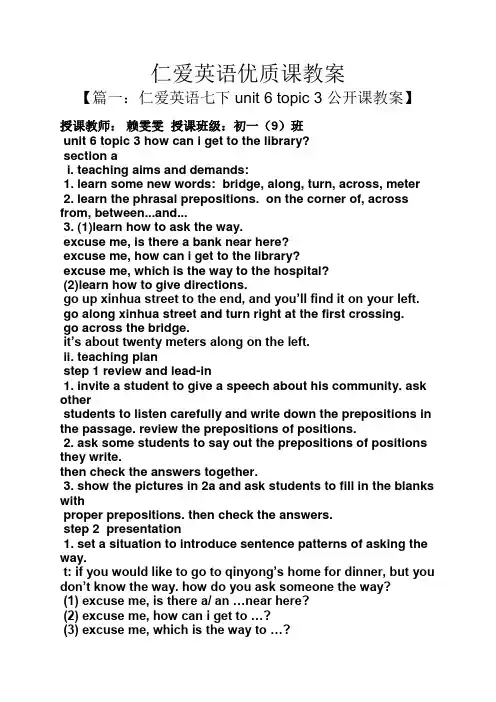
仁爱英语优质课教案【篇一:仁爱英语七下unit 6 topic 3 公开课教案】授课教师:赖雯雯授课班级:初一(9)班unit 6 topic 3 how can i get to the library?section ai. teaching aims and demands:1. learn some new words: bridge, along, turn, across, meter2. learn the phrasal prepositions. on the corner of, across from, between...and...3. (1)learn how to ask the way.excuse me, is there a bank near here?excuse me, how can i get to the library?excuse me, which is the way to the hospital?(2)learn how to give directions.go up xinhua street to the end, and you’ll find it on your left.go along xinhua street and turn right at the first crossing.go across the bridge.it’s about twenty meters along on the left.ii. teaching planstep 1 review and lead-in1. invite a student to give a speech about his community. ask otherstudents to listen carefully and write down the prepositions in the passage. review the prepositions of positions.2. ask some students to say out the prepositions of positions they write.then check the answers together.3. show the pictures in 2a and ask students to fill in the blanks withproper prepositions. then check the answers.step 2 presentation1. set a situation to introduce sentence patterns of asking the way.t: if you would like to go to qinyong’s home for dinner, but you don’t know the way. how do you ask someone the way?(1) excuse me, is there a/ an …near here?(2) excuse me, how can i get to …?(3) excuse me, which is the way to …?2. show some pictures and learn the phrases and sentence patterns ofgiving directions.(1) go up xinhua street to the end.(2) turn left/right at the first crossing.(3) go across the bridge.3. watch a flash and match the pictures with the correct sentences. finish1b.4. let students listen to 1a part by part, follow it and imitate the pronunciation and intonation.step 3 consolidation1. present the key phrases in the dialogs and ask students to match themwith correct meanings. understand 1a.2. work in pairs. give students three minutes to practice 1a in roles.then ask several pairs to act it out.3. group competition. two groups read 1a in roles and the group whichread louder wins. g1—g4 g2—g5g3—g6step 4 practice1. show a map, listen to the conversation and find the way to jane’shome. then check the answer.2. have a competition. listen again and ask students to repeat the dialogsentence by sentence.3. according to the map in 2b, let students suppose they are standing ata and want to go somewhere. make up new conversations like 1a with their partners. and then invite several pairs to act them out. finish 2b step 5 summarymake a summary for section ahomework1. recite 1a.2. finish section a in the workbook.【篇二:最新仁爱版八年级英语下册u7t1sa市级优质课教案】unit 7 topic 1 section a教案unit 7 topic 1 section asectiona needs 1 period. sectiona 需要1课时。
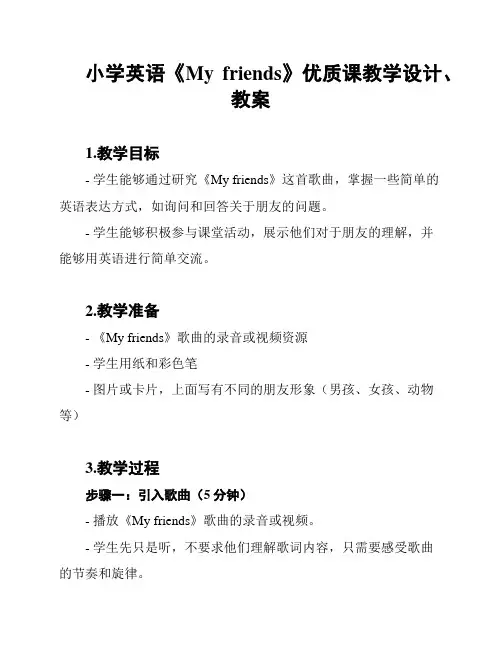
小学英语《My friends》优质课教学设计、教案1.教学目标- 学生能够通过研究《My friends》这首歌曲,掌握一些简单的英语表达方式,如询问和回答关于朋友的问题。
- 学生能够积极参与课堂活动,展示他们对于朋友的理解,并能够用英语进行简单交流。
2.教学准备- 《My friends》歌曲的录音或视频资源- 学生用纸和彩色笔- 图片或卡片,上面写有不同的朋友形象(男孩、女孩、动物等)3.教学过程步骤一:引入歌曲(5分钟)- 播放《My friends》歌曲的录音或视频。
- 学生先只是听,不要求他们理解歌词内容,只需要感受歌曲的节奏和旋律。
步骤二:理解歌词(10分钟)- 给学生发放歌曲的歌词,让他们尝试阅读。
- 分段展示歌词,帮助学生理解词语的意思。
- 逐句解释歌词中一些重要的词汇,如“friend”、“hello”、“goodbye”等。
步骤三:学唱歌曲(15分钟)- 分段教学并示范歌词的发音和语调。
- 按照节奏和旋律,带领学生一起唱歌。
- 反复练直到学生能够熟练地唱出整首歌曲。
步骤四:研究朋友的表达方式(15分钟)- 准备不同的朋友形象的图片或卡片,如男孩、女孩、动物等。
- 指着图片或卡片,教学学生用英语表达不同的朋友形象,如“What's his name?”和“His name is Tom.”。
- 练问问题和回答的对话,鼓励学生互相练。
步骤五:创作自己的朋友(20分钟)- 要求学生用纸和彩色笔,画出一个自己想象中的朋友形象。
- 引导学生使用英语描述自己所画的朋友形象,如“What's your friend like?”和“She is kind and funny.”。
4.教学延伸- 让学生分组进行角色扮演,通过对话的方式表达自己的朋友形象。
- 鼓励学生找来自己的照片,用英语介绍自己的朋友。
5.总结- 回顾学生在这堂课上学到的朋友的表达方式和自我表达的能力。
- 强调学生研究英语不仅是为了研究知识,更是为了能够用英语与他人进行交流。
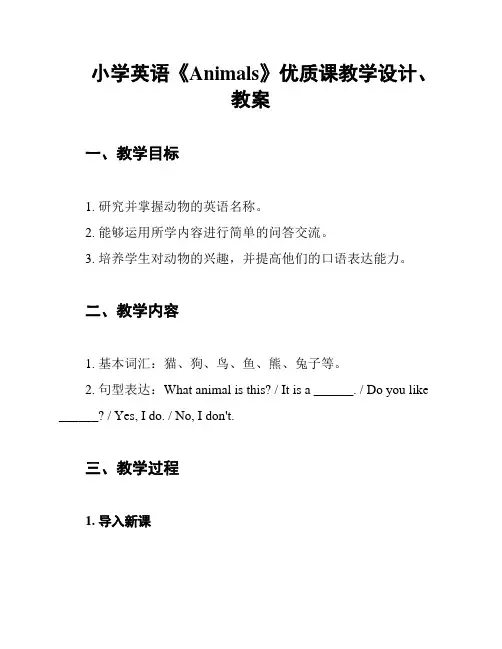
小学英语《Animals》优质课教学设计、教案一、教学目标1. 研究并掌握动物的英语名称。
2. 能够运用所学内容进行简单的问答交流。
3. 培养学生对动物的兴趣,并提高他们的口语表达能力。
二、教学内容1. 基本词汇:猫、狗、鸟、鱼、熊、兔子等。
2. 句型表达:What animal is this? / It is a ______. / Do you like ______? / Yes, I do. / No, I don't.三、教学过程1. 导入新课- 利用图片或实物引入不同的动物,并出示幻灯片以展示动物的英语名称。
2. 研究新词汇- 教师通过情境演示、讲解和示范,引导学生逐个研究新的动物词汇。
3. 句型研究- 教师示范并引导学生模仿,使用句型进行简单的问答交流。
4. 合作活动- 学生分组,每组选择一种动物,利用所学句型进行问答,展示给全班。
5. 温故知新- 教师复以前学过的部分动物名称,并进行回顾、检查。
6. 游戏活动- 教师设计相关游戏活动,激发学生的研究兴趣,并加强对词汇和句型的记忆和运用。
7. 练与巩固- 学生在教师的引导下,进行练和巩固,如简单的问答、填空练等。
8. 总结与反思- 教师引导学生总结当堂课研究的内容,并帮助学生进行反思和提出问题。
四、教学评价- 教师通过观察学生的研究情况、参与度和表现,进行评价和记录。
五、拓展延伸- 学生可自行查找与动物相关的英语材料,进行个人或小组的延伸研究。
六、教学资源- 图片或实物- 幻灯片- 游戏道具等以上是小学英语《Animals》优质课教学设计、教案的初步内容,供参考。
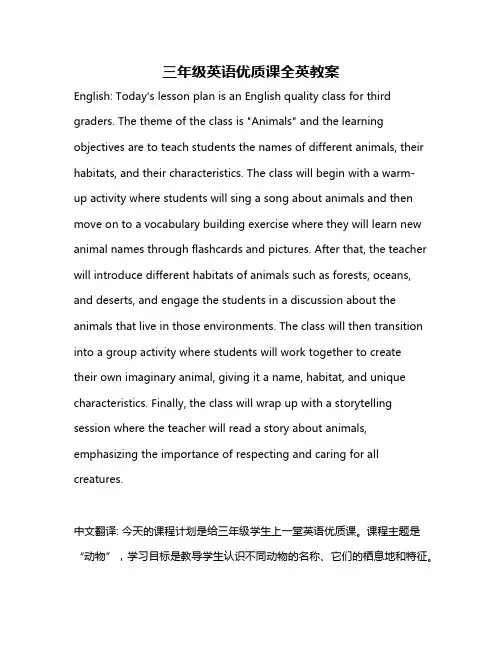
三年级英语优质课全英教案English: Today's lesson plan is an English quality class for third graders. The theme of the class is "Animals" and the learning objectives are to teach students the names of different animals, their habitats, and their characteristics. The class will begin with a warm-up activity where students will sing a song about animals and then move on to a vocabulary building exercise where they will learn new animal names through flashcards and pictures. After that, the teacher will introduce different habitats of animals such as forests, oceans, and deserts, and engage the students in a discussion about the animals that live in those environments. The class will then transition into a group activity where students will work together to createtheir own imaginary animal, giving it a name, habitat, and unique characteristics. Finally, the class will wrap up with a storytelling session where the teacher will read a story about animals, emphasizing the importance of respecting and caring for all creatures.中文翻译: 今天的课程计划是给三年级学生上一堂英语优质课。
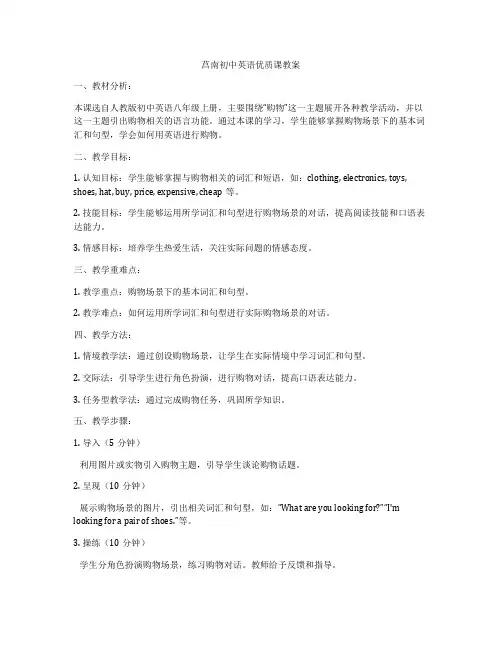
莒南初中英语优质课教案一、教材分析:本课选自人教版初中英语八年级上册,主要围绕“购物”这一主题展开各种教学活动,并以这一主题引出购物相关的语言功能。
通过本课的学习,学生能够掌握购物场景下的基本词汇和句型,学会如何用英语进行购物。
二、教学目标:1. 认知目标:学生能够掌握与购物相关的词汇和短语,如:clothing, electronics, toys, shoes, hat, buy, price, expensive, cheap等。
2. 技能目标:学生能够运用所学词汇和句型进行购物场景的对话,提高阅读技能和口语表达能力。
3. 情感目标:培养学生热爱生活,关注实际问题的情感态度。
三、教学重难点:1. 教学重点:购物场景下的基本词汇和句型。
2. 教学难点:如何运用所学词汇和句型进行实际购物场景的对话。
四、教学方法:1. 情境教学法:通过创设购物场景,让学生在实际情境中学习词汇和句型。
2. 交际法:引导学生进行角色扮演,进行购物对话,提高口语表达能力。
3. 任务型教学法:通过完成购物任务,巩固所学知识。
五、教学步骤:1. 导入(5分钟)利用图片或实物引入购物主题,引导学生谈论购物话题。
2. 呈现(10分钟)展示购物场景的图片,引出相关词汇和句型,如:“What are you looking for?”“I'm looking for a pair of shoes.”等。
3. 操练(10分钟)学生分角色扮演购物场景,练习购物对话。
教师给予反馈和指导。
4. 巩固(10分钟)学生分组进行购物任务,运用所学知识完成任务。
教师观察并给予评价。
5. 总结(5分钟)对本课所学内容进行总结,强调购物场景下的词汇和句型。
6. 作业(5分钟)学生编写一篇关于购物的短文,可以是购物清单、购物经历等。
六、教学反思:本课通过创设购物场景,引导学生进行购物对话和任务,让学生在实际情境中学习词汇和句型。
在教学过程中,要注意关注学生的学习反馈,及时调整教学方法和节奏,确保学生能够掌握所学知识。
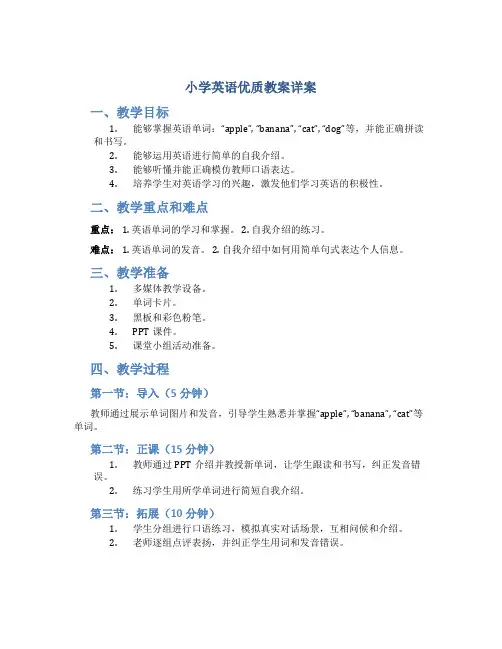
小学英语优质教案详案一、教学目标1.能够掌握英语单词:“apple”, “banana”, “cat”, “dog”等,并能正确拼读和书写。
2.能够运用英语进行简单的自我介绍。
3.能够听懂并能正确模仿教师口语表达。
4.培养学生对英语学习的兴趣,激发他们学习英语的积极性。
二、教学重点和难点重点: 1. 英语单词的学习和掌握。
2. 自我介绍的练习。
难点: 1. 英语单词的发音。
2. 自我介绍中如何用简单句式表达个人信息。
三、教学准备1.多媒体教学设备。
2.单词卡片。
3.黑板和彩色粉笔。
4.PPT课件。
5.课堂小组活动准备。
四、教学过程第一节:导入(5分钟)教师通过展示单词图片和发音,引导学生熟悉并掌握“apple”, “banana”, “cat”等单词。
第二节:正课(15分钟)1.教师通过PPT介绍并教授新单词,让学生跟读和书写,纠正发音错误。
2.练习学生用所学单词进行简短自我介绍。
第三节:拓展(10分钟)1.学生分组进行口语练习,模拟真实对话场景,互相问候和介绍。
2.老师逐组点评表扬,并纠正学生用词和发音错误。
第四节:总结(5分钟)老师和学生共同总结当天学习内容,并展望下节课内容。
五、板书设计英语单词英文发音中文意思apple /ˈæpəl/ 苹果banana /bəˈnɑːnə/香蕉cat /kæt/ 猫dog /dɔːɡ/狗六、教学反思通过本节课的教学,发现学生对于单词发音的掌握仍有待加强,下次课可加入更多发音练习。
同时,学生在自我介绍中表达较为生涩,需要进一步练习句型和流利度。
打算增加更多口语练习时间,提高学生的英语口语表达能力。
以上是本次小学英语优质教案详案,希望对教学工作有所帮助。
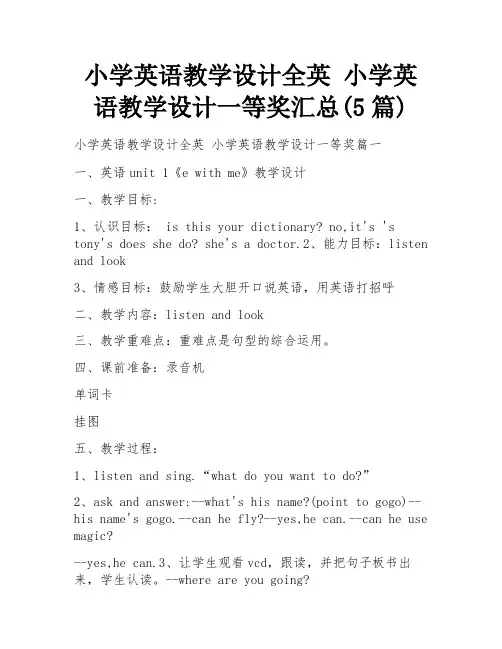
小学英语教学设计全英小学英语教学设计一等奖汇总(5篇)小学英语教学设计全英小学英语教学设计一等奖篇一一、英语unit 1《e with me》教学设计一、教学目标:1、认识目标: is this your dictionary? no,it's 'stony's does she do? she's a doctor.2、能力目标:listen and look3、情感目标:鼓励学生大胆开口说英语,用英语打招呼二、教学内容:listen and look三、教学重难点:重难点是句型的综合运用。
四、课前准备:录音机单词卡挂图五、教学过程:1、listen and sing.“what do you want to do?”2、ask and answer:--what's his name?(point to gogo)--his name's gogo.--can he fly?--yes,he can.--can he use magic?--yes,he can.3、让学生观看vcd,跟读,并把句子板书出来,学生认读。
--where are you going?--i'm going to an island.--we can't fly.--e withme./let's go.4、师生操练、生生操练句型。
5、呈现listen and look,要求学生把听到的句子说出来。
6、pair work and act.7、point and say.8、homework(1)把课文读给家长听。
(2)表演与同学的对话,用英语问候老师和同学。
六、板书设计: unit one e with me--where are you going?--i'm going to an island.--we can't fly.--e with me./let's go.七、教学反思:小部分学生比较难上口,需要反复读说。
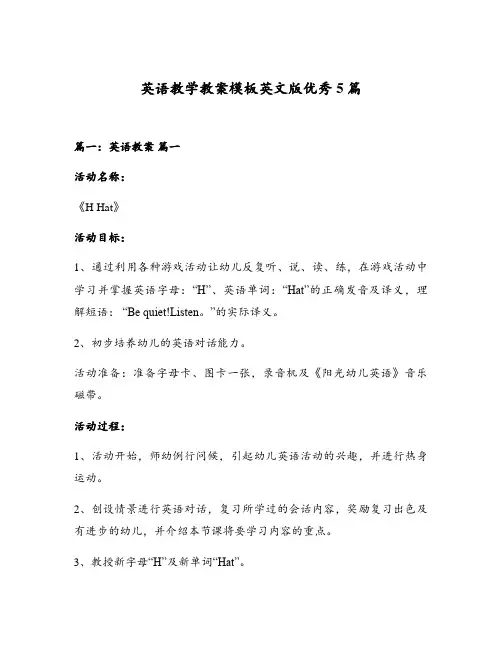
英语教学教案模板英文版优秀5篇篇一:英语教案篇一活动名称:《H Hat》活动目标:1、通过利用各种游戏活动让幼儿反复听、说、读、练,在游戏活动中学习并掌握英语字母:“H”、英语单词:“Hat”的正确发音及译义,理解短语:“Be quiet!Listen。
”的实际译义。
2、初步培养幼儿的英语对话能力。
活动准备:准备字母卡、图卡一张,录音机及《阳光幼儿英语》音乐磁带。
活动过程:1、活动开始,师幼例行问候,引起幼儿英语活动的兴趣,并进行热身运动。
2、创设情景进行英语对话,复习所学过的会话内容,奖励复习出色及有进步的幼儿,并介绍本节课将要学习内容的重点。
3、教授新字母“H”及新单词“Hat”。
(1)教师出示字母娃娃H,让幼儿说出像什么,在拼贴字母的过程中学会字母“H”的正确发音。
(2)教师利用图卡引出“帽子”的英语单词,通过游戏“贴帽子”让幼儿反复练习强化,逐渐掌握单词“Hat”的正确发音及译义。
4、律动教学。
教授幼儿短语“Be quiet!Listen。
”的实际译义及相应的动作。
5、教师小结,叮嘱幼儿:“回家要看VCD,回家要听录音机,回家要当Melody!”篇二:高中英语教学设计篇二一、课程类型:高三复习课二、教学目标:一) 认知目标1、句型和语言点(见教学重点)。
2、用所学的知识与伙伴进行交流、沟通,学会改错、写作。
二)情感目标利用多媒体手段营造积极和谐教学氛围,使学生不自觉地进入情景之中,充分调动学生的思维活动和情感体验,引起学生的共鸣。
三)智力目标在运用语言的过程中培养学生的观察力、分析力、想象力和自学能力,帮助学生加强记忆力,提高思维能力和运用英语的综合能力,激发创造能力。
三、教材分析:这是高三复习阶段的一节写作课。
这节书面表达课就从审题谋篇等方面入手来完成教学目的,侧重于引导学生在把握书面表达的写作前准备即谋篇审题能力,使学生在动手写作前迅速构思按照规范的模式来完成谋篇审题:在教学中不仅仅强调写,对于与写作紧密联系的听、说、读、改错都有兼顾。
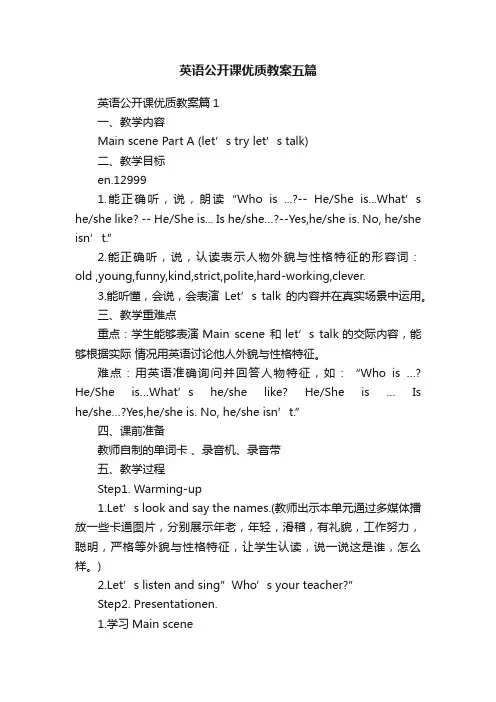
英语公开课优质教案五篇英语公开课优质教案篇1一、教学内容Main scene Part A (let’s try let’s talk)二、教学目标en.129991.能正确听,说,朗读“Who is ...?-- He/She is...What’s he/she like? -- He/She is... Is he/she…?--Yes,he/she is. No, he/she isn’t.”2.能正确听,说,认读表示人物外貌与性格特征的形容词:old ,young,funny,kind,strict,polite,hard-working,clever.3.能听懂,会说,会表演Let’s talk 的内容并在真实场景中运用。
三、教学重难点重点:学生能够表演Main scene 和let’s talk的交际内容,能够根据实际情况用英语讨论他人外貌与性格特征。
难点:用英语准确询问并回答人物特征,如:“Who is …? He/She is…What’s he/she like? He/She is … Is he/she…?Yes,he/she is. No, he/she isn’t.”四、课前准备教师自制的单词卡、录音机、录音带五、教学过程Step1. Warming-up1.Let’s look and say the names.(教师出示本单元通过多媒体播放一些卡通图片,分别展示年老,年轻,滑稽,有礼貌,工作努力,聪明,严格等外貌与性格特征,让学生认读,说一说这是谁,怎么样。
)2.Let’s listen and sing”Who’s your teacher?”Step2. Presentationen.1.学习Main scene(1)出示Main scene中的部分教学挂图,让学生观察。
(2)看图回答问题。
Dialogue1: Who can you see in the picture?(Wu Yifan,Amy,Oliver and a teacher.)Dialogue2: What are they talking about?(The teacher introduces classmates to each other.)Dialogue2:Who is a new student?(Oliver)(3)听录音,模仿朗读,理解对话内容。
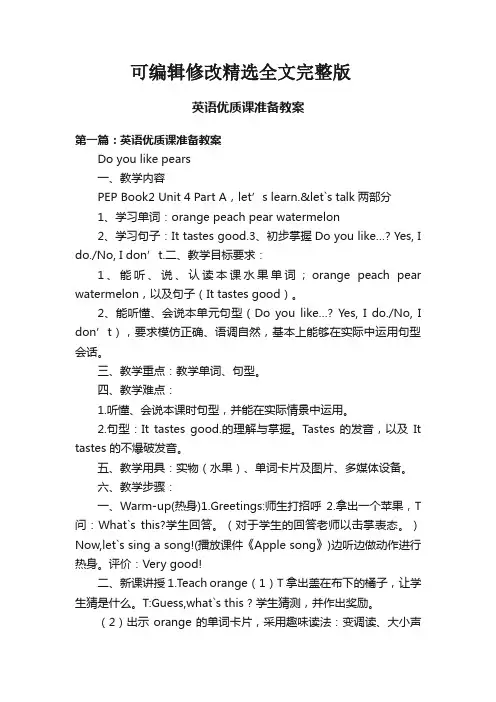
可编辑修改精选全文完整版英语优质课准备教案第一篇:英语优质课准备教案Do you like pears一、教学内容PEP Book2 Unit 4 Part A,let’s learn.&let`s talk两部分1、学习单词:orange peach pear watermelon2、学习句子:It tastes good.3、初步掌握Do you like…? Yes, I do./No, I don’t.二、教学目标要求:1、能听、说、认读本课水果单词;orange peach pear watermelon,以及句子(It tastes good)。
2、能听懂、会说本单元句型(Do you like…? Yes, I do./No, I don’t),要求模仿正确、语调自然,基本上能够在实际中运用句型会话。
三、教学重点:教学单词、句型。
四、教学难点:1.听懂、会说本课时句型,并能在实际情景中运用。
2.句型:It tastes good.的理解与掌握。
Tastes 的发音,以及It tastes 的不爆破发音。
五、教学用具:实物(水果)、单词卡片及图片、多媒体设备。
六、教学步骤:一、Warm-up(热身)1.Greetings:师生打招呼2.拿出一个苹果,T 问:What`s this?学生回答。
(对于学生的回答老师以击掌表态。
)Now,let`s sing a song!(播放课件《Apple song》)边听边做动作进行热身。
评价:Very good!二、新课讲授 1.Teach orange(1)T拿出盖在布下的橘子,让学生猜是什么。
T:Guess,what`s this ? 学生猜测,并作出奖励。
(2)出示orange的单词卡片,采用趣味读法:变调读、大小声读、抢读等方式。
(同时板书)练习Chant: orange, orange.I like you!(师生齐拍手)教师用手势:one orangetwo orangesthree oranges T:Do you like oranges?(让学生回答)引导说出Yes,I do!No,I don`t!(带上动作^∧^ ^_^)出示句型卡:Do you like,师生接读。

英语优质公开课教案〔精选10篇〕英语优质公开课教案〔精选10篇〕英语优质公开课教案篇1教学目的:1.学习有关职业的单词。
2.会说自己或别人的职业和在什么地方工作。
3.会询问别人在什么地方工作。
4.新单词:driver farmer soldier nurse factory station bus station hospital farmpost office study 句型:一般如今时陈述句、特殊疑问句和应答。
I am a farmer. Where does Wu Bin work? He works ina factory.教学用具:录音机,PPT多媒体课件(lesson教学演示) 、或者动画多媒体课件people and work、图片或实物等。
教学步骤:Step 1 Revision[参考一]让学生表达自己家庭情况,如:家中有几口人,父母的职业,祖父母的职业等。
值日生本人表达完成之后,由老师向全班同学提问。
即:What’shis / her father / mother? Is she / he a teacher? / a worker? Where does he /she work? Does he /she work in a factory / school?等。
这一局部问提老师可先提问根底较好的同学或与值日惹事先配合好,使之更好的起到承上启下的作用。
或者老师让学生复习基数词1—100。
[参考二]老师运用PPT多媒体课件中的revision。
向学生提问题:What’s his / her father / mother? Isshe / he a teacher? / a worker? Where does he / she work? Does he /she work in afactory / school?等,可以让学生看着课件中显示的问题答复。
反复操练使学生能纯熟的运用这些句型。
全国学校英语优质课教案你知道怎么写全国学校英语优质课教案吗能在图片的提示下听懂、认读、说出新单词:computer game、jipsaw puzzel、careful、fix,并懂得其意。
一起看看全国学校英语优质课教案!欢送查阅!全国学校英语优质课教案1教学目标:1、语言目标(Language skills)稳固和强化上节课的学问:can I have Yes, you can./ No, you cant. 能在图片的提示下听懂、认读、说出新单词:computer game、jipsaw puzzel、careful、fix,并懂得其意。
学会表达某人拥有某物的功能句型“I’ve got 。
He’s got。
She’s got。
It’s got。
〞来进行沟通。
2、技能目标(Objectives of skills)学会运用have got 表述拥有某物3、情感目标(Objectives of emotion and attitude)让同学通过自由对话沟通自己拥有的东西,到达让其开口说英语的目的,从而激发他们学习英语的爱好及运用英语沟通的热忱。
重点难点:能正确拼读新单词:computer game、jipsaw puzzel、careful、fix; 理解本课句型:I have got。
并能够运用此句型和别人沟通自己拥有的东西。
教学过程:Step1、Warming up:Greeting. T: Hello, boys and girls!S: Hello, teacher!T: How are you, todayS: Fine, thank you.T:What’s the weather like todayS:It’s sunny day.设计意图:以简洁轻松的问候进入一个比拟愉悦的课堂教学。
Step 2、Lead-in:老师指自己的物品,如课本、衣服等问。
T:what’s this S:This is a book;This is a coat.T:This is my book. I’ve got a book. This is my coat. I’ve got a coat. (板书并做动作让同学理解意思I’ve got )让同学运用I’ve got——像老师一样描述自己拥有的东西。
一份完整的英语教案范例一份完整的英语教案范例篇1教学目的:1、知识与技能:本课要求学生能正确听、说、读、单词bathroom,bathtub,dishes,kichen,living room,refigerator,room,shower,sink,stove,toilet,clean,dirty,cook,dry,make,wash,mine,yours。
会口头运用句子:“ What time is it ? It’s ”。
情感态度价值观:1通过复习单词和对话,系统学生的知识体系,激发学生学习英语的爱好。
2 通过小组合作学习,强化合作意识。
3通过情景对话,培育学生学习英语的爱好和综合运用语言的能力。
教学重点、难点:本课重点句子,会正确使用句子。
教具准备:tapes,cards教学过程:Step 1Class opening and Review1) Greeting2) ReviewStep2:Read the wordsbathroom,bathtub,dishes,kichen,living room,refigerator,room,shower,sink,stove,toilet,clean,dirty,cook,dry,make,wash,mine,yoursStep 3Write them.Step4DrillWhat time is it ? It’s _________ ”。
1:45 one forty five2:10 two ten5:37 five thirty seven8:00 eight o’clock3)Extend knowledge :2:10 two ten or ten past two4:30 four thirty or half past three9:00 nine o’clock or nine 教学侧记Step 5An exam一.根据汉语意思写出正确的单词。
英语优秀教案英语优秀教案15篇作为一位不辞辛劳的人民教师,就难以避免地要准备教案,借助教案可以更好地组织教学活动。
那么你有了解过教案吗?以下是小编为大家收集的英语优秀教案,仅供参考,大家一起来看看吧。
英语优秀教案1教材分析《英语课程标准》的总体目标是培养学生的综合语言运用能力。
本单元的话题是“My home”.家与我们的日常生活密切相关,学生对家的布局都有比较清晰地了解,本课时围绕家展开的一般疑问句也是日常生活中使用频率很高的用语。
学生表达英语的愿望会比较强烈,对课堂的活动会更有积极参与的兴趣。
学情分析四年级的学生对英语学习已经有了一定的经验并养成了良好的学习习惯,他们对英语学习有强烈的兴趣与求知欲。
他们好奇心强,爱说,爱玩,善于模仿,直观形象记忆能力比较强,我们要充分利用这些特点进行精心的课堂设计。
在本单元中,学生在第一课时学会了家庭各个房间的名称,初步识记了单词,但是还不是很牢固,需要进一步强化。
我创设了一个邀请学生到我家来的情景,并把教室布置成我家的样子,学生从感官和情感两方面被吸引住,积极地进入了教学过程。
教学目标根据《英语课程标准》的教学理念,教材特点以及四年级学生的实际情况,将本课时的教学目标确定如下:(认知目标)能听懂,会说句型“Is this your bedroom? Yes,it/she/he is./No,it/she/he isn’t.”(以上的一般疑问句是本节课的重点难点)I have a new……””where’s ……?”(能力目标) 通过对话的学习,学生能灵活运用所学句子,交际能力得到进一步发展。
(情感目标)通过活动,游戏使学生产生学习英语的兴趣,培养他们的合作意识和竞争意识,培养他们对家的热爱。
教学重点和难点重点:掌握“Is this your bedroom? Yes,it/she/he is./No,it/she/he isn’t.”等句式难点:掌握home与house的区别。
小学英语《My country》优质课教学设计、教案1. 教学目标本节课的教学目标是帮助学生了解并掌握有关自己国家的基本信息,发展学生的听、说、读、写能力,培养他们的国家荣誉感和爱国情感。
2. 教学准备- 课件:包括介绍国家的图片、地图和相关信息- 板书:标题为《My Country》,列出国家名称、国旗、语言、食物等要素3. 教学过程步骤1: 引入- 利用图片、地图等教具引入课题,激发学生对国家的兴趣。
步骤2: 介绍国家- 展示国旗的图片,问学生这是哪个国家的旗帜。
引导学生说出国家名称,并写在板书上。
- 展示国家地图,指出国家的位置,并简单介绍国家的特点和地理位置。
步骤3: 研究国家的语言- 展示国家的语言文字,并教授一些简单的用语,如问候语、数字等。
要求学生跟读并模仿。
步骤4: 了解国家的食物- 介绍国家的典型特色食物,如汉堡包、披萨等,并展示相关图片。
让学生尝试说出食物的名称,并了解一些相关的文化背景。
步骤5: 概括国家的特点和文化- 引导学生用简短的词语或句子来概括国家的特点和文化。
鼓励学生用英语表达自己的观点。
步骤6: 温故知新- 复本节课学到的知识点,让学生回答一些相关问题,加深他们对国家的理解和记忆。
4. 教学评估- 在教学过程中观察学生的参与度和理解程度。
- 进行一些简单的口头问答或书面练,如问答、填空等,以评估学生掌握情况。
5. 课后延伸- 布置相关的课后作业,如写一篇关于自己国家的短文或制作一个海报。
- 鼓励学生在家中进一步了解和探索有关国家的信息。
该教学设计和教案旨在帮助学生了解和熟悉自己国家的基本信息,以及培养他们的爱国情感和文化自豪感。
同时,通过听、说、读、写的综合活动,提高学生的英语能力和跨文化交际能力。
小学英语教案全英文版(优秀13篇)小学英语全英文教案范文篇一Goood moring, Im glad to interpret my lesson here . The lesson plan I am going to talk about is Part A lets learn of unit1 PEP Primary English book7. I will explain how to teach and the reason for doing this from following aspects.Ⅰ analysis of the teaching content.Ⅰ ways of teaching and learning .Ⅰ teaching proceduresⅠ blackboard designV assessmentNow Let;s focus on the analysis of teaching content. It can be divided into 3 parts as followed: the status and the function, the teaching objectives , the main points and difficult points, I;ll talk about it one by one.This lesson is the first lesson of unit 1, book7 . It includes two parts: Let;s learn and let;s play. In section 1, it mainly deals with these key phrases: on foot, by bike, by bus, by train, by subway. And in section 2, it provides a game for the Ss to prastise the patterns: How do you go to? And the answer: I go by../ on foot.Our students have already known some vehicles in the daily life. It;s not difficult for them to understand and use these words . If students can learn it well, it will help students to learn the rest of this unit. So, I set the following aims:The first is language objectivesTo make sure that students can read, recognize and use these key phrases :on foot ,by bike,by bus,by train skillfully.The next is ability objectives(1) To develop Ss; abilities of listening and speaking.(2) To train the Ss; ability of working in groups.moral objectives(1)to help students know some vehicles and comprehend the traffic rules(2) To foster Ss; consciousness of good co-operation and proper competition.The main points and difficult points about this lesson is:(1) To make sure that Ss can use these key phrases correctly and skillfully.(2) To enable Ss to study in groups and co-operate skillfully.(3) To develop Ss; interest in English.Difficult pointsTo help the Ss ask and answer the question “How do you go to?part Ⅰways of teaching and learningAs we all know: the main instructional aims of learning English in primary school is to cultivate pupils; basic abilities of listening and speaking and their good sense of the English language. So in this lesson I;ll mainly use “Task-based” teaching method. That is to say, I will let the Ss learn in real situations, finish a task by making a survey”How do you go to school?” to help Ss to get a better understanding of the key phrases. I will arrange these activities: guessing game, finishing a survey and having a competition. And in this lesson a recorder, CAI, will be needed.partⅠ teaching proceduresI;ll finish this lesson in five steps.step1 lead--in activitiesI will begin my class with drawing and guessing game, just like this : I show students some vehicles such as bike ,bus ,jeep which they learned before by Stick Figures and ask them guess what;s it.Purpose: It is important to form a better English learning surrounding for the Ss by guessing game. and at the same time it provides situations to review learned knowledge for the next step.step2 prestentationNow I;ll mainly talk about this step.1、first there is a Free talk between T and Ss. For example: I show many pictures of beautiful cities and ask students some questions, such as do you like this city?where do you want to go ?and help Ss to answer them with by train ,by plane,by ship.By the way, I show the picture of a school, and say“ I go to schiool by bus” ,Ss read this sentence. do the actions and ask how do you go to school?,show many pictures of tools such as ,on foot by bike ,by bus to help students answer my question one by one.To present the key structures one by one is much easier for the Ss to learn and grasp the meanings.2 With the help of the CAI I set a situation to help Ss understand the way of using these key phrases:A boy is coming, who is going to school. He says: I go to school byThen play the sounds of bus, bike ask students to listen carefully and tell “I go to school by according to the different sounds, by the way , I present another new phrases:by subwayPurpose:Make Ss use these new phrases with sentence structures, to help Ss use the language in a real situation.step3 practise3 I order to make every student read these new phrases correctly, I design a drill in this step,I show cards as soon as possible ,students should read the words quickly and spell them. Then I ask How do you go to school?students answer I go to ......also I will quicken the speed to ask .The purpose is to draw the whole studentsattention to the spelling of the words4 After this, I ask Ss to do Lets play in fours. They use places cards and vehicle cards, ask and answer:How do you go to ? I go to by”5, If Ss can ask and answer expertly, I will ask them to make a short dialogue.the purpose of this is to help students to learn those sentenses through a ture situation and make the dialogues in order to check if Ss can usse these key prases、sentences structures skillfullystep 4 consolidationlet students do a survey about how do you go to school?and the table like this :write down names and tools another Ss chooseTask-based teaching method is used here to develop Ss; ability of ; communication and also their ability of co-operation will be well trained.step 5 homeworkask students to collect other kinds of transport tools through the library ,computer.the purpose of this is to stimulate the interest of learning english and to wide the studentsknowledgestep6 blackboard designmy blackboard design like this :on the left Ishow the phrases:on foot,by bus.......on the right there are many sentences:how do you go to school?I go to ......step 7 assessmentdue to the studentsage ,I make every students work in class through many activities in order to stimulate the studentsinterest and provide they a wide thinking room. I make students learn this lesson very well through desiring scene statuesthats all,thank you for your listening !Unit 1 Lesson 篇二Part A Let;s say, Let;s chant Part C CultureTeaching Aims :1、Be able to listen, say, recognize the words: apple, ant, boy, bag, Coke, coffee.2、Be able to listen, say, read and write these three letters: A a; B b; C c3、Through the chant review the letters of ABC, train a sense of group identity.Focus Points amp; Difficult Points :Read the letters: Big letter C, small letter c; Write down them correctly and handsomely.Teaching Preparation:1、Letter cards ,some word pictures, word cards: apple boy eraser ant crayon body head cake Coke coffee bag ball2、A little blackboard with four-line format and a ball.Designing for the blackboard:panda beaver eagle kangaroo (pictures)China Canada America Australia (words)Teaching Steps:Step1. Warm ndash;up1、Sing a song.2、Free talkT: Hello. I;m Wendy. I;m from Hangzhou.S1: Hello! I;m 。
第1篇Subject: English Language ArtsGrade Level: 9th GradeDuration: 90 minutesObjective:The main objective of this lesson is to enhance students' reading, comprehension, and analytical skills through the study of a short story. Students will learn to analyze characters, themes, and literary devices, and they will also practice speaking and writing skills in an English language context.Materials:- Projector and computer for displaying the text and images- Copies of the short story "The Yellow Wallpaper" by Charlotte Perkins Gilman- Whiteboard and markers- Handouts with vocabulary and discussion questions- Writing materials (pens, pencils, paper)- Access to online resources for additional background informationPreparation:1. Choose a short story that is appropriate for the age and readinglevel of the students. For this lesson, "The Yellow Wallpaper" by Charlotte Perkins Gilman is a suitable choice due to its interesting themes and accessible language.2. Create handouts with vocabulary words and discussion questions.3. Prepare a PowerPoint presentation or other visual aids to accompany the text.4. Research the author and the historical context of the story to provide background information for the students.Lesson Procedure:I. Introduction (10 minutes)1. Begin the class with a brief introduction to Charlotte Perkins Gilman and her work. Discuss the historical context of "The Yellow Wallpaper" and its significance.2. Project the title of the story and ask students to predict what they think the story might be about based on the title.II. Reading the Text (15 minutes)1. Divide the class into small groups and assign each group a section of the story to read aloud.2. As the groups read, encourage them to take notes on characters, themes, and any literary devices they notice.3. After each group has read their assigned section, have a brief discussion with the whole class to summarize the events and highlight key points.III. Analysis and Discussion (20 minutes)1. Introduce the concept of literary analysis by discussing what makes a character dynamic or a theme significant.2. Using the handouts, guide the students through analyzing the characters of the story, focusing on the narrator and her husband.3. Discuss the themes of the story, such as the treatment of women, mental illness, and the oppressive nature of societal norms.4. Introduce and explain various literary devices used in the story, such as symbolism, foreshadowing, and point of view.5. Facilitate a class discussion on these themes and devices, encouraging students to share their thoughts and interpretations.IV. Vocabulary and Comprehension (10 minutes)1. Review the vocabulary words provided in the handout and ask students to define them using the context of the story.2. Conduct a short comprehension quiz to ensure students understand the main points of the story.V. Creative Writing (15 minutes)1. Divide the class into pairs and assign each pair a character from the story.2. Instruct students to write a diary entry from the perspective oftheir assigned character, reflecting on the events of the story andtheir emotions.3. Allow students to share their entries with the class.VI. Conclusion (10 minutes)1. Summarize the key points of the lesson and discuss what students have learned about analyzing literature.2. Encourage students to think about how the themes of the story relate to modern society.3. Assign a reflective writing task for homework, asking students to write an essay on the impact of "The Yellow Wallpaper" on their understanding of literature and society.Assessment:- Participation in class discussions and group activities- Completion of the vocabulary and comprehension quiz- Quality of the creative writing assignment- Completion of the reflective essayExtensions:- Organize a debate on the treatment of women in the story and its relevance today.- Invite a guest speaker to discuss the history of mental health treatment and its evolution.- Create a poster or presentation that visually represents the themes of the story.Note:This教案 is designed to be adaptable to different learning styles and abilities. Teachers may need to adjust the timing and content based on the specific needs of their students.第2篇Subject: English Language ArtsGrade Level: Grade 8Course Duration: 2 hoursObjective:1. To enhance students' practical English communication skills.2. To develop students' ability to express opinions and ideas fluentlyin English.3. To foster a positive and interactive learning environment that encourages student participation and collaboration.Teaching Aids:- Projector and screen for presentations- Whiteboard and markers- Handouts with discussion prompts and activities- English language dictionaries- Video clips related to the topic- HeadphonesLesson Overview:This lesson focuses on a practical English activity that involves group discussion, role-playing, and a creative project. The topic for the lesson is "The Impact of Technology on Our Lives."I. Introduction (10 minutes)1. Warm-up Activity:- Start the class with a quick vocabulary review related to technology.- Ask students to share examples of technology they use daily.2. Introduction to the Topic:- Briefly introduce the topic of the lesson: "The Impact of Technology on Our Lives."- Explain the importance of discussing this topic and how it relates to their daily lives.II. Group Discussion (20 minutes)1. Divide the class into small groups (3-4 students per group).2. Distribute handouts with discussion prompts:- How has technology changed the way we communicate?- What are the advantages and disadvantages of using technology?- How does technology affect our social lives?- How can we use technology responsibly?3. Monitor the discussions and provide guidance as needed.4. Encourage students to express their opinions and back them up with examples or evidence.III. Role-Playing (20 minutes)1. Divide students into pairs or small groups.2. Assign each group a scenario related to the impact of technology,such as:- A family meeting to discuss whether to purchase a new smartphone.- A school debate on the use of social media in the classroom.- A community meeting to discuss the effects of internet addiction.3. Provide students with guidelines on how to conduct the role-play, including speaking clearly, listening actively, and respecting different viewpoints.4. Monitor the role-plays and provide feedback on pronunciation, fluency, and content.IV. Creative Project (30 minutes)1. Instruct students to work in pairs or small groups to create a presentation on the impact of technology on their lives.2. The presentation can be in the form of a poster, a video, a skit, ora speech.3. Provide students with guidelines on what to include in their presentation:- Introduction to the topic- Key points related to the impact of technology- Personal experiences or examples- Conclusions and recommendations4. Allow students to work on their presentations while providing guidance and support as needed.V. Presentation and Reflection (20 minutes)1. Select a few groups to present their projects to the class.2. Encourage the rest of the class to ask questions and provide feedback after each presentation.3. Conduct a brief reflection activity:- Ask students to write down one positive and one negative impact of technology on their lives.- Discuss the responses as a class and encourage students to think critically about the role of technology in their lives.VI. Conclusion (10 minutes)1. Summarize the key points discussed during the lesson.2. Encourage students to continue exploring the topic of technology in their daily lives and to think about how they can use technology responsibly.3. Assign a homework task related to the topic, such as writing a short essay on "How Technology Has Changed My Life."Assessment:- Participation in group discussions and role-plays- Quality of the creative project- Completion of the homework taskAdditional Notes:- Ensure that the classroom environment is conducive to learning, with comfortable seating and a clear layout.- Use a variety of teaching methods to engage students, such as interactive activities, real-life examples, and multimedia resources.- Be prepared to adapt the lesson plan based on the students' needs and responses.- Provide opportunities for students to practice and reinforce their English language skills throughout the lesson.第3篇Subject: English Language TeachingGrade Level: Grade 8Duration: 2 HoursClass Objective:To develop students' practical communication skills in English, particularly in the context of daily interactions. Students will be able to engage in a simulated dialogue, use appropriate vocabulary and grammar structures, and express their opinions confidently.Teaching Methods:- Interactive group discussions- Role-playing- Collaborative learning- Task-based learningMaterials:- Whiteboard and markers- Projector and computer (for displaying visual aids)- Handouts with role-play scenarios and vocabulary lists- Timetable for group activitiesLesson Overview:Part 1: Introduction (10 minutes)- Greet the students and review the previous lesson’s key points.- Introduce the theme of the class: "Daily Interactions."- Explain the objectives and structure of the lesson.Part 2: Warm-up Activity (10 minutes)- Conduct a quick vocabulary quiz related to daily interactions (e.g., "Hello," "How are you?", "What’s your name?", "Where are you from?").- Students will pair up and practice the vocabulary in a realistic conversation.Part 3: Role-Playing Scenarios (30 minutes)- Divide the class into small groups.- Distribute handouts with different role-playing scenarios, such as greeting someone at a store, asking for directions, or making a restaurant reservation.- Each group will have a few minutes to prepare their role-play.- Have each group perform their role-play in front of the class, and encourage the rest of the students to provide feedback.Part 4: Vocabulary and Grammar Focus (20 minutes)- Introduce key vocabulary related to daily interactions (e.g., "Excuse me," "May I have…", "Could you please…").- Review grammar structures that are relevant to the scenarios (e.g., present simple tense, polite requests).- Provide examples and have students practice using the vocabulary and grammar in sentences.Part 5: Collaborative Learning Activity (30 minutes)- Divide the class into pairs.- Each pair will be given a scenario that requires them to work together to solve a problem or complete a task.- The scenarios can be related to shopping, travel, or social situations.- Students will have to use the vocabulary and grammar they have learned to communicate effectively.Part 6: Reflection and Feedback (10 minutes)- Have each pair share their experience with the class.- Discuss what they found challenging and what they enjoyed about the activity.- Provide constructive feedback on the students' communication skills.Part 7: Homework Assignment (5 minutes)- Assign a short writing task where students have to write a dialogue using the vocabulary and grammar structures they have learned.- Encourage students to create their own scenarios and characters.Evaluation:- Observation of student participation and engagement throughout the lesson.- Assessment of the quality of the role-plays and the effectiveness of the vocabulary and grammar use.- Feedback from the homework assignment.Teaching Notes:- Ensure that the class is conducted in an inclusive and supportive environment where all students feel comfortable participating.- Provide clear instructions and models for the role-playing scenarios.- Encourage students to take risks and not be afraid to make mistakes.- Use positive reinforcement to acknowledge students' efforts and progress.Conclusion:This lesson aims to provide students with practical opportunities to use English in real-life situations. By engaging in role-plays, vocabulary exercises, and collaborative tasks, students will develop their communication skills and confidence in using English.。